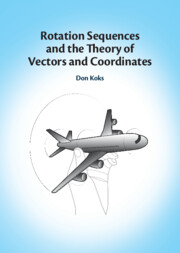Book contents
- Frontmatter
- Contents
- Preface
- 1 Setting the Scene
- 2 Trigonometry, the Foundation of Coordinate Theory
- 3 The Vector Dot and Cross Products
- 4 Vector Preliminaries and Constructing a Basis
- 5 Converting Vector Coordinates Across Bases
- 6 Vector Rotation in Two and Three Dimensions
- 7 Rotation Sequences and the Fundamental Theorem
- 8 Coordinate Systems for Earth, and More Rotation Sequences
- 9 The Role of Quaternions in Rotation Theory
- 10 Time Dependence of Vehicle Attitude
- 11 Frame Dependence of the Time Derivative
- 12 Earth’s Orientation in Space, and Time on Earth
- 13 Orbital Mechanics
- 14 Rigid-Body Dynamics
- 15 Modelling the Motion and Attitude of a Vehicle
- 16 Concepts of Tensor Analysis
- Index
16 - Concepts of Tensor Analysis
Published online by Cambridge University Press: 17 April 2025
- Frontmatter
- Contents
- Preface
- 1 Setting the Scene
- 2 Trigonometry, the Foundation of Coordinate Theory
- 3 The Vector Dot and Cross Products
- 4 Vector Preliminaries and Constructing a Basis
- 5 Converting Vector Coordinates Across Bases
- 6 Vector Rotation in Two and Three Dimensions
- 7 Rotation Sequences and the Fundamental Theorem
- 8 Coordinate Systems for Earth, and More Rotation Sequences
- 9 The Role of Quaternions in Rotation Theory
- 10 Time Dependence of Vehicle Attitude
- 11 Frame Dependence of the Time Derivative
- 12 Earth’s Orientation in Space, and Time on Earth
- 13 Orbital Mechanics
- 14 Rigid-Body Dynamics
- 15 Modelling the Motion and Attitude of a Vehicle
- 16 Concepts of Tensor Analysis
- Index
Summary
Books on vehicle attitude and motion often use tensors in their analyses, and I have discussed the reasons for that in a previous chapter. But tensors also carry an esotericism arising from being used to quantify the curved spacetime of general relativity. And so I end the book by telling the inquisitive reader how tensors ‘work’ more generally, and how this more advanced topic makes quick work of calculating the gradient, divergence, laplacian, and curl of vector calculus. I end with a discussion of parallel transport, which has found its way into the exotic ‘wander azimuth’ axes used in some navigation systems.
- Type
- Chapter
- Information
- Rotation Sequences and the Theory of Vectors and Coordinates , pp. 509 - 548Publisher: Cambridge University PressPrint publication year: 2025

